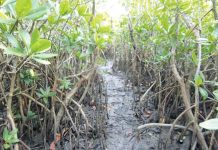
A TOTAL of 2,610 waterbirds were seen flocking in five wetlands in Iloilo during the Annual Waterbird Census conducted by Community Environment and Natural Resources Office (CENRO)-Guimbal Wildlife Conservation Section and Wildlife Traffic Monitoring Unit.
Different migratory waterbirds with diverse colors and features were sighted in the wetlands located at Barangays of Sooc and San Jose in Arevalo district; Hinactacan in La Paz district; Bitoon in Jaro district and at Katunggan Park in Sitio Panus-on, Nabitasan, Leganes on Jan 4 and Jan. 7-10, 2020.
The team of CENRO Guimbal used binoculars and a spotting scope to sight and count the migratory waterbirds bound to save their own species by looking for temporary habitat to feed and breed.
Twenty-five (25) species of migratory birds namely Black-winged Stilt, Purple Heron, Whistling Duck, Marsh Sandpiper, Javan Pond Heron, Common Kingfisher, Whiskered Tern, Gull-billed Tern, Little Egret, Intermediate Egret, White-browed Crake, Moorhen, Whimbrel, White-collared Kingfisher, Sea Collared Kingfisher, Redshank, Common Greenshank, Grey Heron, Plover, Wood Sandpiper, Philippine Duck, Northern Pintail, Wandering Whistling-duck, Asian House Martin and Osprey took their annual escape from the winter in temperate regions.
Here in the Philippines, the peak months for birds migrating to the south are usually during September to November, while those travelling to the north often occur between February and April.

Wetlands play various roles in the protection of our environment by reducing the impacts of floods, absorb pollutants and improve water quality. It serves as a safe haven for different species of migratory birds in search for their food, temporary home and breeding grounds.
Migratory birds are often threatened by human activities through the conversion of ecosystems for development purposes. The Department of Environment and Natural Resources, through the Biodiversity Management Bureau closely work with organizations of bird watchers and other wildlife enthusiasts to protect migratory bird sites.
Wetlands are rich in natural resources. It also protects the birds as well as the people in the community. “It is important to conserve the wetlands as they become a transitory abode to migratory birds. We aim for more prolific wetlands that may incline migration of birds to the areas. This can be another ecotourism attractions in the City of Love,” said regional executive director Francisco E. Milla, Jr. of the Department of Environment and Natural Resources Region 6./PN



